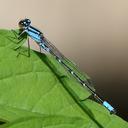United States and Canada
The head and thorax blue and black. The pale postocular spots are large and generally well separated by the absence of an occipital bar. The abdomen is more robust than in other bluets and almost entirely black except for the basal and apical segments. In both sexes, on segment 2 there is a distinctive black diamond-shaped spot dorsally. In the male segments 8-9 are pale blue and in the female there are a pair of large blue basal spots; these are occasionally fused but segment 9 is always black. The middle lobe of the female prothorax bears pair of shallow posterolateral pits.
Size: Total length: 19-29 mm; abdomen: 14-22 mm; hindwing: 12-17 mm.
Similar Species (south-central US): The larger Turquoise Bluet (E. divagans) lacks the diamond-shaped spot and ventrolateral stripe on abdominal segment 2. Azure Bluet (E. aspersum) has blue dorsally on segment 7 and Stream Bluet (E. exsulans) has black dorsally on segment 8. Lilypad Forktail (Ischnura kellicotti) is also similar, but it has larger postocular spots, segment 2 has a large dorsal basal blue spot and apical band, and segment 9 in females is either blue or red. Female Seepage Dancers (Argia bipunctulata) may also be mistaken for this species, but abdominal segment 8 is blue dorsally in Skimming Bluet. The more western Neotropical Bluet (E. novahispaniae) females are similar, but segment 9 has some blue on it.
Habitat: Prefers open, muddy, heavily vegetated ponds and lakes with fish, and more rarely slow moving streams and swampy, small order streams.
Natural History: One study found this species exclusively in lakes containing fish and suggested that Skimming Bluet may be restricted to breeding in such situations to avoid predation by abundant dragonfly larvae in fishless lakes. My observations agree with this, as large populations of the Skimming Bluet have been studied in a heavily vegetated southern Oklahoma pond, with ample fish (including bass and Lepomis spp. ) on a regular seasonal basis. Skimming Bluet is most active in the morning, flying out over the water, perching on algae and other vegetation. Mating pairs aggregate on riparian branches and stems. The female lays eggs unaccompanied by the male in algae and floating debris. This species appears to be a poor disperser, with adults generally returning to their home waters. References: McPeek (1989).
Distribution: Eastern U.S. and southern Canada from Florida to Quebec westward to Minnesota and south to Oklahoma and Texas.
Source: Abbott, J.C. 2006-2010. OdonataCentral: An online resource for the distribution and identification of Odonata. Available at OdonataCentral.
Edited by Drew Weber (9/24/2015).
